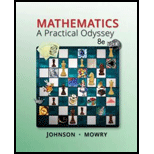
Concept explainers
Classify each argument as deductive and inductive.
| a. 1. Hitchcock’s “Psycho” is a suspenseful movie. |
| 2. Hitchcock’s “The Birds” is a suspenseful movie. |
| Therefore, all Hitchcock’s movies are suspenseful. |
| b. 1. All Hitchcock movies are suspenseful. |
| 2. “Psycho” is a Hitchcock movie. |
| Therefore, “Psycho” is a suspenseful. |
a)
To classify:
The nature of given argument.
Answer to Problem 1CR
Solution:
The given argument is inductive.
Explanation of Solution
Given:
The given argument is,
1. Hitchcock’s “Psycho” is a suspenseful movie.
2. Hitchcock’s “The Birds” is a suspenseful movie.
Therefore, all Hitchcock’s movies are suspenseful.
Definition:
Deductive reasoning involves the application of general statement for a specific case.
Inductive reasoning involves the going from a specific case to a general statement.
If the conclusion of an argument is guaranteed the argument is deductive and if the conclusion of an argument is not guaranteed the argument is inductive.
Approach:
In given argument the premises do not support the argument.
The premises support the argument that all Hitchcock’s movies are suspenseful but there is not 100% guarantee.
Therefore, the argument is inductive.
Conclusion:
The given argument is inductive.
b)
To classify:
The nature of given argument.
Answer to Problem 1CR
Solution:
The given argument is deductive.
Explanation of Solution
Given:
The given argument is,
1. All Hitchcock movies are suspenseful.
2. “Psycho” is a Hitchcock movie.
Therefore, “Psycho” is a suspenseful.
Definition:
Deductive reasoning involves the application of general statement for a specific case.
Inductive reasoning involves the going from a specific case to a general statement.
If the conclusion of an argument is guaranteed the argument is deductive and if the conclusion of an argument is not guaranteed the argument is inductive.
Approach:
In given argument both the premises support the argument.
Therefore, the conclusion is true.
The argument is deductive.
Conclusion:
The given argument is deductive.
Want to see more full solutions like this?
Chapter 1 Solutions
Mathematics: A Practical Odyssey
- The rate at which a substance grows is given by R'(x) = 105e0.3x, where x is the time (in days). What is the total accumulated growth during the first 2.5 days? Set up the definite integral that determines the accumulated growth during the first 2.5 days. 2.5 Growth = (105e0.3x) dx 0 (Type exact answers in terms of e.) Evaluate the definite integral. Growth= (Do not round until the final answer. Then round to one decimal place as needed.)arrow_forwardFind the total area of the shaded regions. y 18- 16- 14- 12- 10- 8- 6- y=ex+1-e 4- 2- 0- 2 3 4 5 -2 -4- X ☑ The total area of the shaded regions is (Type an integer or decimal rounded to three decimal places as needed.)arrow_forwardThe graph of f(x), shown here, consists of two straight line segments and two quarter circles. Find the 19 value of f(x)dx. 小 Srxdx. 19 f(x)dx y 7 -7 2 12 19 X ☑arrow_forward
- Can you solve this two numerical method eqn and teach me.arrow_forwardFind the area between the following curves. x=-4, x=2, y=ex, and y = 3 - ex Set up the integral (or integrals) needed to compute this area. Use the small (Type exact answers in terms of e.) 3 In 2 A. S √ [3-2e*] dx+ -4 2 S [2ex-3] dx 3 In 2 B. dx Find the area between the curves. Area = (Type an exact answer in terms of e.)arrow_forwardUse the definite integral to find the area between the x-axis and f(x) over the indicated interval. Check first to see if the graph crosses the x-axis in the given interval. f(x)=8-2x²: [0,4] Set up the integral (or integrals) needed to compute this area. Use the smallest possible number of integrals. Select the correct choice below and fill in the answer boxes to ○ A. dx B. 2 S 8-2x² dx+ 4 S 2 8-2x2 dx C. dx + S dx For the interval [0,4], the area between the x-axis and f(x) is (Type an integer or a simplified fraction.)arrow_forward
- Pollution from a factory is entering a lake. The rate of concentration of the pollutant at time t is 5 given by P'(t) = 126t², where t is the number of years since the factory started introducing pollutants into the lake. Ecologists estimate that the lake can accept a total level of pollution of 600 units before all the fish life in the lake ends. Can the factory operate for 2 years without killing all the fish in the lake? Set up the integral that would determine the pollution level after 2 years. 2 5 126t 2 dt Can the factory operate for 2 years without killing all the fish in the lake? Thee factory can operate for 2 years without killing all the fish in the lake because the value of the integral is , which is less than 600. (Round to the nearest integer as needed.)arrow_forwardUse the definite integral to find the area between the x-axis and f(x) over the indicated interval. Check first to see if the graph crosses the x-axis in the given interval. f(x)=4x-12; [2,6] The area between the x-axis and f(x) is (Type an integer or a simplified fraction.)arrow_forwardEvaluate the definite integral. 70 √5√2-6 3 dz 70 S 5√2-6 dz= 7 江 (Type an integer or decimal rounded to two decimal places as needed.)arrow_forward
- Find the area between the following curves. 2 y=x³-x²+x+4; y=5x² -7x+4 The area between the curves is (Simplify your answer.) ...arrow_forwardFind the area of the shaded region. 3- -1 -3- Q The total area of the shaded regions is (Simplify your answer.) y=9-x² Q 1 3 5 Xarrow_forwardFind the area of the region bounded by the graphs of the given equations. y=17x, y=x² ... The area is (Type an integer or a simplified fraction.)arrow_forward
 Trigonometry (MindTap Course List)TrigonometryISBN:9781305652224Author:Charles P. McKeague, Mark D. TurnerPublisher:Cengage Learning
Trigonometry (MindTap Course List)TrigonometryISBN:9781305652224Author:Charles P. McKeague, Mark D. TurnerPublisher:Cengage Learning
